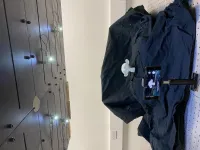Early warning system fills in gaps in infectious disease surveillance
2021-01-11
(Press-News.org) Researchers at Columbia University Mailman School of Public Health developed an infectious disease early warning system that includes areas lacking health clinics participating in infectious disease surveillance. The approach compensates for existing gaps by optimally assigning surveillance sites that support better observation and prediction of the spread of an outbreak, including to areas remaining without surveillance. Details are published in the journal Nature Communications.
The research team, including Jeffrey Shaman and Sen Pei, have been at the forefront of forecasting and analyzing the spread of COVID-19. Their highly cited paper in the journal Science Advances estimated the number of lives saved had physical distancing and other measures taken effect one week earlier. They have also led the development of methods to forecast other infectious diseases, including seasonal influenza.
The new early warning system optimizes the selection of surveillance sites then applies a computer model to data from these sites in order to forecast the geographic spread of influenza, including to rural areas lacking surveillance. The researchers say their method would be effective for other respiratory outbreaks, including human metapneumovirus and seasonal coronavirus, which have similar transmission routes. It can also be modified to work with other diseases.
"Our goal was to design a way to provide a cost-effective early warning system so public health officials can quickly respond to outbreaks and prevent further spread," says first author Sen Pei, PhD, associate research scientist in the Department of Environmental Health Sciences at the Columbia Mailman School. "Our method can be used to support development of a more robust surveillance system and to identify where to set up or improve surveillance."
"Too often infectious outbreaks spread undetected due to gaps in surveillance at the community level. These gaps have contributed to tragic and unnecessary illness and loss of life, as we have seen over the past year," says senior author Jeffrey Shaman, PhD, a professor in the Department of Environmental Health Sciences at the Columbia Mailman School. "Our method can help fill these gaps to prevent these unwanted outcomes, and provide guidance on where to invest in greater surveillance."
The researchers validated their approach using historical data, demonstrating its ability to forecast the spread of past outbreaks at the state and county levels. At state level, they used real-world data in 35 states from the U.S. Armed Forces Health Surveillance Branch (AFHSB), for influenza during nine seasons (2008-2009 to 2016-2017), and human metapneumovirus and seasonal coronavirus during four seasons (2013-2014 to 2016-2017). At the county level, they validated their method using a model-generated (virtual) outbreak since there are no historical data available in the majority of counties. The method they developed can generate more accurate near-term forecasts than alternative methods tested by the researchers, such as those that prioritize locations with large populations or use a random selection.
According to U.S. Centers for Disease Control and Prevention, the U.S. Influenza Surveillance System collects data from participating outpatient healthcare clinics in all U.S. states, Puerto Rico, the District of Columbia, and the U.S. Virgin Islands--but not in every U.S. county. Participation of healthcare providers is voluntary, and may change over time. Each week, approximately 3,000 providers report data to CDC on the total number of patients seen for any reason and the number of those patients with influenza-like illness.
INFORMATION:
Co-authors include Xian Teng, a PhD student in School of Computing and Information at University of Pittsburgh, and Paul Lewis, MD, MPH, a preventive medicine physician and acting chief for Integrated Biosurveillance at AFHSB.
The research is supported by U.S. National Institutes of Health (GM110748), Defense Advanced Research Projects Agency (W911NF-16-2-0035), and a gift from the Morris-Singer Foundation.
ELSE PRESS RELEASES FROM THIS DATE:
2021-01-11
Fast facts:
This study describes essential differences between marine and freshwater species and the contributions of viruses to such differences
The results may help guide future bioengineering efforts to develop plant strains adapted to grow in salt-water, which is of local and regional food security interest
Microalgae are fundamental to global ecosystems due to their ability to sustain coral reef species and produce atmospheric oxygen
Before this study, many important algal phyla did not have sequenced representatives
Viruses have contributed to the evolution of algae and their genome makeups
Abu Dhabi, UAE, January 11, 2021: NYU Abu Dhabi (NYUAD) ...
2021-01-11
It is well known that the expansion of the universe is accelerating due to a mysterious dark energy. Within galaxies, stars also experience an acceleration, though this is due to some combination of dark matter and the stellar density. In a new study to be published in Astrophysical Journal Letters researchers have now obtained the first direct measurement of the average acceleration taking place within our home galaxy, the Milky Way. Led by Sukanya Chakrabarti at the Institute for Advanced Study with collaborators from Rochester Institute of Technology, University of Rochester, and ...
2021-01-11
Moms are not more likely than other women to support gun control efforts. In fact, a new study finds that parenthood doesn't have a substantial effect on the gun control views of men or women.
"Everybody 'knows' that moms are more politically liberal on gun control issues," says Steven Greene, corresponding author of the study and a professor of political science at North Carolina State University. "We wanted to know if that's actually true. And, as it turns out, it's not true - which was surprising."
To explore the impact of parenthood on people's gun control views, the researchers drew on data collected by the Pew Center for Research in 2017 as part of Pew's nationally ...
2021-01-11
Lithium-ion batteries are critical for modern life, from powering our laptops and cell phones to those new holiday toys. But there is a safety risk - the batteries can catch fire.
Zinc-based aqueous batteries avoid the fire hazard by using a water-based electrolyte instead of the conventional chemical solvent. However, uncontrolled dendrite growth limits their ability to provide the high performance and long life needed for practical applications.
Now researchers have reported in Nature Communications that a new 3D zinc-manganese nano-alloy anode has overcome the limitations, resulting in a stable, high-performance, dendrite-free aqueous battery using seawater ...
2021-01-11
In diseases characterized by bone loss -such as periodontitis, rheumatoid arthritis, and osteoporosis- there is a lot that scientists still don't understand. What is the role of the immune response in the process? What happens to the regulatory mechanisms that protect bone?
In a paper published recently in Scientific Reports, researchers from the Forsyth Institute and the Universidad de Chile describe a mechanism that unlocks a piece of the puzzle. Looking at periodontal disease in a mouse model, scientists found that a specific type of T cell, known as regulatory T cells, start behaving in unexpected ways. These cells lose their ability to regulate bone ...
2021-01-11
WASHINGTON -- As LEDs replace traditional lighting systems, they bring more smart capabilities to everyday lighting. While you might use your smartphone to dim LED lighting at home, researchers have taken this further by tapping into dynamically controlled LEDs to create a simple illumination system for 3D imaging.
"Current video surveillance systems such as the ones used for public transport rely on cameras that provide only 2D information," said Emma Le Francois, a doctoral student in the research group led by Martin Dawson, Johannes Herrnsdorf and Michael Strain at the University of Strathclyde in the ...
2021-01-11
BUFFALO, N.Y. -- Scientists have known for years that mutations in the MLL4 gene can cause Kabuki syndrome, a rare developmental disorder.
But a study published on Jan. 11 in Nature Communications illuminates new details regarding how this occurs. (Images are available by contacting Charlotte Hsu in UB Media Relations at chsu22@buffalo.edu.)
The research suggests that MLL4 controls the production of neurons that secrete growth hormone-releasing hormone (GHRH) in a part of the brain called the hypothalamus. Mice without working copies of the MLL4 gene in this area had stunted growth and markedly fewer GHRH neurons. Mice with only one functioning ...
2021-01-11
CLEVELAND - As reported in Nature Communications, researchers from Cleveland Clinic's Lerner Research Institute have developed a novel, patient-derived model of ulcerative colitis, which will help advance studies into new treatments for the chronic inflammatory bowel disease.
The team used the model to identify a promising target that could be inhibited to slow disease progression.
Ulcerative colitis is characterized by abnormal reactions of the immune system that lead to inflammation and ulcers on the inner lining of the large intestines. It is a highly heterogeneous condition, both in terms of patients' symptoms and disease pathology.
Suppressing the overactive immune response with anti-inflammatory drugs is the current ...
2021-01-11
Use of telehealth jumped sharply during the first months of the coronavirus pandemic shutdown, with the approach being used more often for behavioral health services than for medical care, according to a new RAND Corporation study.
Between mid-March and early May 2020, telehealth was used by more than 40% of patients with a chronic physical health condition and by more than 50% of those with a behavioral health condition, according to findings published in the Journal of General Internal Medicine.
Overall, almost half of the people who were undergoing treatment when the pandemic shutdown ...
2021-01-11
In countries with a severe shortage of surgeons it is common for some operations to be carried out by medical staff with lower formal qualifications. Researchers at Karolinska Institutet, Sweden, have led an international study on the safety and efficacy of a common surgical procedure. The study, published in
JAMA Network Open, shows that inguinal hernia operations performed by associate clinicians at a hospital in Sierra Leone were just as safe and effective as those performed by doctors.
Many Sub-Saharan countries have a desperate shortage of surgeons, and to ensure that as many patients as possible can be treated, some operations are carried out by medical professionals who are not specialists in surgery. Such task sharing is supported by several bodies, including the World Health ...
LAST 30 PRESS RELEASES:
[Press-News.org] Early warning system fills in gaps in infectious disease surveillance





